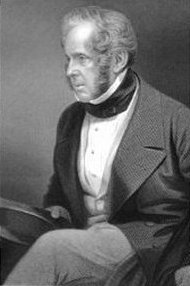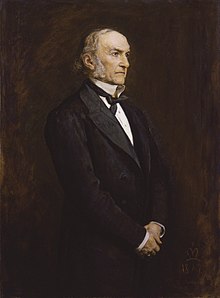
A | B | C | D | E | F | G | H | CH | I | J | K | L | M | N | O | P | Q | R | S | T | U | V | W | X | Y | Z | 0 | 1 | 2 | 3 | 4 | 5 | 6 | 7 | 8 | 9
Liberal Party | |
|---|---|
 | |
| Founder | John Russell, 1st Earl Russell |
| Founded | 9 June 1859 |
| Dissolved | 2 March 1988 |
| Merger of | |
| Succeeded by | Liberal Democrats (majority) Liberal Party (UK, 1989) (minority) |
| Headquarters | Offices at the National Liberal Club, 1 Whitehall Place, London |
| Youth wing | Young Liberals |
| Ideology | |
| National affiliation | SDP–Liberal Alliance (1981–1988) |
| European affiliation | Federation of European Liberal Democrats (1976–1988) |
| International affiliation |
|
| European Parliament group |
|
| Northern Irish affiliate | Ulster Liberal Party (1956–1987) |
| Colours |
|
| Anthem | "The Land" |
| Conference | Liberal Assembly |
| This article is part of a series on |
| Liberalism in the United Kingdom |
|---|
 |
| Part of a series on |
| Liberalism |
|---|
 |
The Liberal Party was one of the two major political parties in the United Kingdom, along with the Conservative Party, in the 19th and early 20th centuries.[3] Beginning as an alliance of Whigs, free trade-supporting Peelites, and reformist Radicals in the 1850s, by the end of the 19th century, it had formed four governments under William Gladstone. Despite being divided over the issue of Irish Home Rule, the party returned to government in 1905 and won a landslide victory in the 1906 general election. Under prime ministers Henry Campbell-Bannerman (1905–1908) and H. H. Asquith (1908–1916), the Liberal Party passed reforms that created a basic welfare state.[4] Although Asquith was the party leader, its dominant figure was David Lloyd George.
Asquith was overwhelmed by his wartime role as prime minister and Lloyd George led a coalition that replaced him in late 1916. However, Asquith remained as Liberal Party leader. The split between Lloyd George's breakaway faction and Asquith's official Liberal faction badly weakened the party.[5] The coalition government of Lloyd George was increasingly dominated by the Conservative Party, which finally ousted him as prime minister in 1922. Liberal collapse was quick and catastrophic. With 400 MPs elected in the 1906 election; they had only 40 in 1924. Their share of the popular vote plunged from 49% to 18%. The Labour Party absorbed most of the ex-Liberal voters and now became the Conservatives' main rival.[6]
By the 1950s, the party had won as few as six seats at general elections. Apart from a few notable by-election victories, its fortunes did not improve significantly until it formed the SDP–Liberal Alliance with the newly formed Social Democratic Party (SDP) in 1981. At the 1983 general election, the Alliance won over a quarter of the vote, but won only 23 of the 650 seats it contested. At the 1987 general election, its share of the vote fell below 23% and the Liberals and the SDP merged in 1988 to form the Social and Liberal Democrats (SLD), who the following year were renamed the Liberal Democrats. A splinter group reconstituted the Liberal Party in 1989.[7]
The Liberals were a coalition with diverse positions on major issues and no unified national policy. This made them repeatedly liable to deep splits, such as that of the Liberal Unionists in 1886 (they eventually joined the Conservative Party); the faction of labour union members that joined the new Labour Party; the split between factions led by Asquith and that led by Lloyd George in 1918-1922; and a three-way split in 1931.[8] Many prominent intellectuals were active in the party, including philosopher John Stuart Mill, economist John Maynard Keynes, and social planner William Beveridge. Winston Churchill during his years as a Liberal, 1904-1924 authored Liberalism and the Social Problem (1909).[9]
History
Origins

The Liberal Party grew out of the Whigs, who had their origins in an aristocratic faction in the reign of Charles II and the early 19th century Radicals. The Whigs were in favour of reducing the power of the Crown and increasing the power of Parliament. Although their motives in this were originally to gain more power for themselves, the more idealistic Whigs gradually came to support an expansion of democracy for its own sake. The great figures of reformist Whiggery were Charles James Fox (died 1806) and his disciple and successor Earl Grey. After decades in opposition, the Whigs returned to power under Grey in 1830 and carried the First Reform Act in 1832.
The Reform Act was the climax of Whiggism, but it also brought about the Whigs' demise. The admission of the middle classes to the franchise and to the House of Commons led eventually to the development of a systematic middle-class liberalism and the end of Whiggery, although for many years reforming aristocrats held senior positions in the party. In the years after Grey's retirement, the party was led first by Lord Melbourne, a fairly traditional Whig, and then by Lord John Russell, the son of a Duke but a crusading radical, and by Lord Palmerston, a renegade Irish Tory and essentially a conservative, although capable of radical gestures.
As early as 1839, Russell had adopted the name of "Liberals", but in reality, his party was a loose coalition of Whigs in the House of Lords and Radicals in the Commons. The leading Radicals were John Bright and Richard Cobden, who represented the manufacturing towns which had gained representation under the Reform Act. They favoured social reform, personal liberty, reducing the powers of the Crown and the Church of England (many Liberals were Nonconformists), avoidance of war and foreign alliances (which were bad for business) and above all free trade. For a century, free trade remained the one cause which could unite all Liberals.
In 1841, the Liberals lost office to the Conservatives under Sir Robert Peel, but their period in opposition was short because the Conservatives split over the repeal of the Corn Laws, a free trade issue; and a faction known as the Peelites (but not Peel himself, who died soon after) aligned to the Liberal side on the issue of free trade. This allowed ministries led by Russell, Palmerston and the Peelite Lord Aberdeen to hold office for most of the 1850s and 1860s. A leading Peelite was William Gladstone, who was a reforming Chancellor of the Exchequer in most of these governments. The formal foundation of the Liberal Party is traditionally traced to 1859 when the remaining Peelites, Radicals and Whigs agreed to vote down the incumbent Conservative government. This meeting was held at the Willis' rooms in London on 6 June 1859. This led to Palmerston's second government.
However, the Whig-Radical amalgam could not become a true modern political party while it was dominated by aristocrats and it was not until the departure of the "Two Terrible Old Men", Russell and Palmerston, that Gladstone could become the first leader of the modern Liberal Party. This was brought about by Palmerston's death in 1865 and Russell's retirement in 1868. After a brief Conservative government (during which the Second Reform Act was passed by agreement between the parties), Gladstone won a huge victory at the 1868 election and formed the first Liberal government. The establishment of the party as a national membership organisation came with the foundation of the National Liberal Federation in 1877. The philosopher John Stuart Mill was also a Liberal MP from 1865 to 1868.[10]
Gladstone era

For the next thirty years Gladstone and Liberalism were synonymous. William Gladstone served as prime minister four times (1868–74, 1880–85, 1886, and 1892–94). His financial policies, based on the notion of balanced budgets, low taxes and laissez-faire, were suited to a developing capitalist society, but they could not respond effectively as economic and social conditions changed. Called the "Grand Old Man" later in life, Gladstone was always a dynamic popular orator who appealed strongly to the working class and to the lower middle class. Deeply religious, Gladstone brought a new moral tone to politics, with his evangelical sensibility and his opposition to aristocracy.[11] His moralism often angered his upper-class opponents (including Queen Victoria), and his heavy-handed control split the Liberal Party.[12][13]
In foreign policy, Gladstone was in general against foreign entanglements, but he did not resist the realities of imperialism. For example, he ordered the occupation of Egypt by British forces in the 1882 Anglo-Egyptian War.[14] His goal was to create a European order based on co-operation rather than conflict and on mutual trust instead of rivalry and suspicion; the rule of law was to supplant the reign of force and self-interest. This Gladstonian concept of a harmonious Concert of Europe was opposed to and ultimately defeated by a Bismarckian system of manipulated alliances and antagonisms.[15]
As prime minister from 1868 to 1874, Gladstone headed a Liberal Party which was a coalition of Peelites like himself, Whigs and Radicals. He was now a spokesman for "peace, economy and reform". One major achievement was the Elementary Education Act 1870 (33 & 34 Vict. c. 75), which provided England with an adequate system of elementary schools for the first time. He also secured the abolition of the purchase of commissions in the British Army and of religious tests for admission to Oxford and Cambridge; the introduction of the secret ballot in elections; the legalization of trade unions; and the reorganization of the judiciary in the Judicature Act.[16]
Regarding Ireland, the major Liberal achievements were land reform, where he ended centuries of landlord oppression, and the disestablishment of the (Anglican) Church of Ireland through the Irish Church Act 1869.
Zdroj:https://en.wikipedia.org?pojem=The_Liberal_Party_(UK)
Text je dostupný za podmienok Creative Commons Attribution/Share-Alike License 3.0 Unported; prípadne za ďalších podmienok. Podrobnejšie informácie nájdete na stránke Podmienky použitia.
Antropológia
Aplikované vedy
Bibliometria
Dejiny vedy
Encyklopédie
Filozofia vedy
Forenzné vedy
Humanitné vedy
Knižničná veda
Kryogenika
Kryptológia
Kulturológia
Literárna veda
Medzidisciplinárne oblasti
Metódy kvantitatívnej analýzy
Metavedy
Metodika
Text je dostupný za podmienok Creative
Commons Attribution/Share-Alike License 3.0 Unported; prípadne za ďalších
podmienok.
Podrobnejšie informácie nájdete na stránke Podmienky
použitia.
www.astronomia.sk | www.biologia.sk | www.botanika.sk | www.dejiny.sk | www.economy.sk | www.elektrotechnika.sk | www.estetika.sk | www.farmakologia.sk | www.filozofia.sk | Fyzika | www.futurologia.sk | www.genetika.sk | www.chemia.sk | www.lingvistika.sk | www.politologia.sk | www.psychologia.sk | www.sexuologia.sk | www.sociologia.sk | www.veda.sk I www.zoologia.sk
